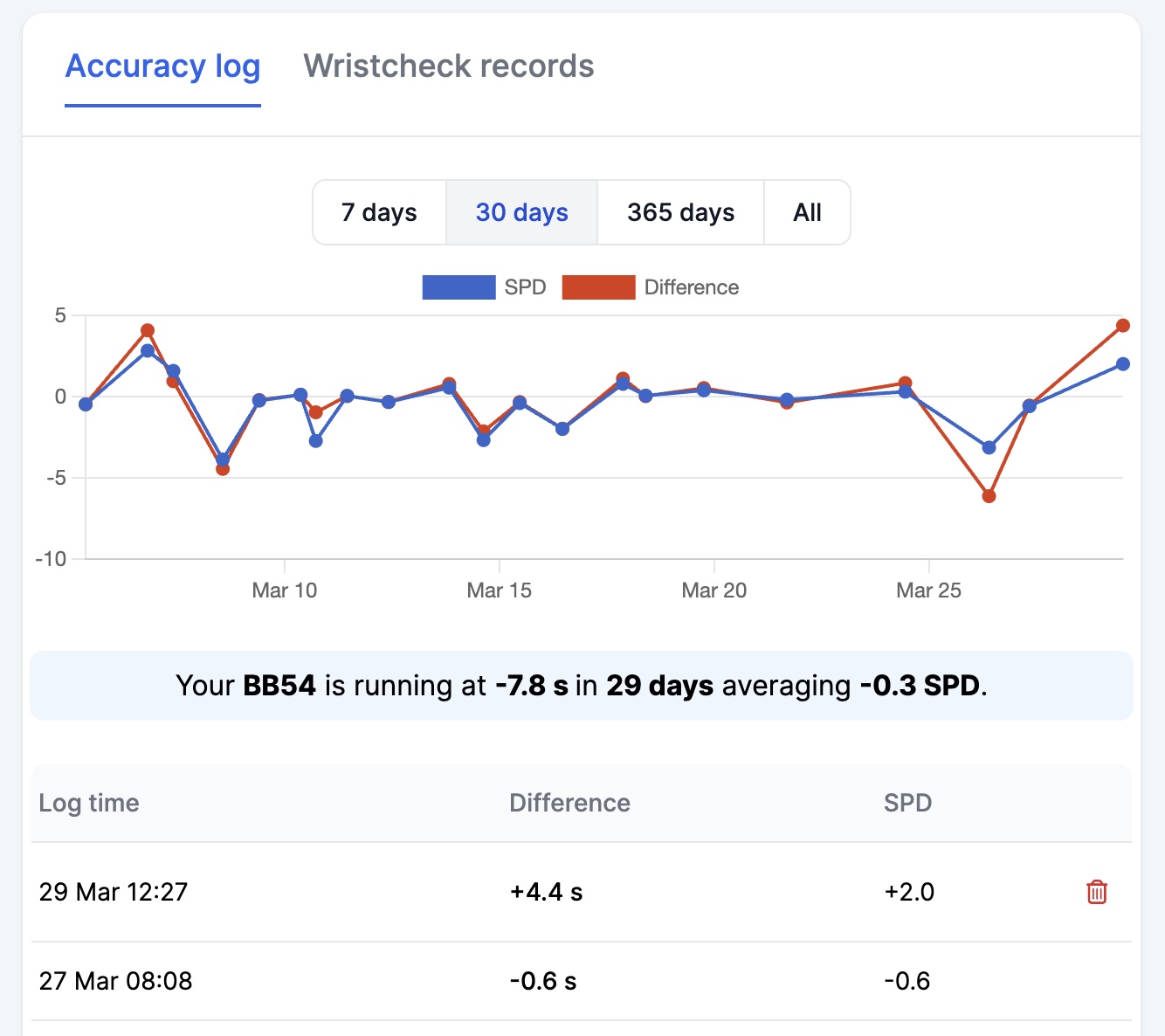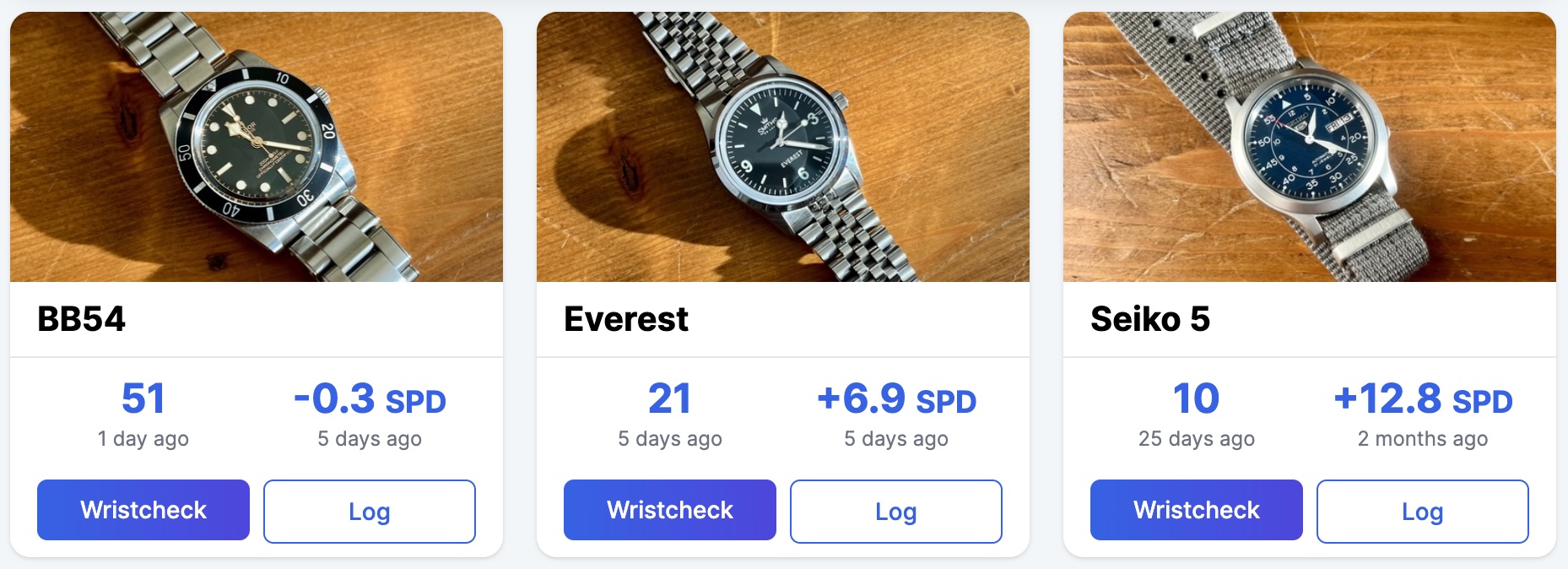If you're a WristLog user, you're already familiar with the SPD (seconds per day) measurements displayed prominently next to each watch in your collection. But what do these numbers really tell us about our beloved timepieces, and how can we use this information to better understand and care for our watches? Let's dive into the fascinating world of mechanical watch accuracy.

What is SPD?
SPD, or seconds per day, is the standard measurement used to express how much time a watch gains or loses over a 24-hour period. It's essentially a snapshot of your watch's performance:
- Positive SPD (+SPD): Your watch is running fast, gaining seconds each day
- Negative SPD (-SPD): Your watch is running slow, losing seconds each day
- Zero SPD: The mythical perfect accuracy (spoiler: no mechanical watch maintains this consistently)
Looking at my WristLog dashboard, you might notice that my Seiko 5 shows "+12.8 SPD" while my BB54 displays "-0.3 SPD." This means the Seiko is gaining approximately 12.8 seconds each day, while the BB54 is losing a mere 0.3 seconds—practically perfect timekeeping for a mechanical watch.

What's "Good" Accuracy?
Watch accuracy expectations should vary based on the type of watch you own:
| Watch Type | Expected Accuracy (SPD) | Industry Standard |
|---|---|---|
| Standard Mechanical | ±15-40 seconds | - |
| COSC Certified Chronometer | -4 to +6 seconds | ISO 3159 |
| Master Chronometer | 0 to +5 seconds | METAS |
| Typical Quartz | ±15-30 seconds per month | - |
| High Accuracy Quartz (HAQ) | ±5-10 seconds per year | - |
When reviewing WristLog data, context matters. That Seiko 5 running at +12.8 SPD is actually performing admirably for a modestly priced mechanical watch, while COSC-certified watch like Black Bay 54 should maintain accuracy within the stricter standards for which it was certified.
Understanding Accuracy Patterns
The real value of tracking SPD over time in WristLog is identifying patterns. Watch accuracy is influenced by numerous factors:
Position
Mechanical watches typically perform differently depending on their position due to gravity's effect on the movement:
- Dial up
- Dial down
- Crown up
- Crown down
- Crown left
- Crown right
This is why watchmakers time watches in multiple positions during regulation. Your wearing patterns and how you store your watch overnight can significantly impact observed accuracy.
Temperature
Temperature fluctuations can cause metals in the movement to expand or contract, affecting timekeeping:
- Cold environments typically cause watches to run slower
- Warm environments generally cause watches to run faster
If you notice your watch's SPD changes with the seasons, this is likely why.
Power Reserve
Many watches show different accuracy characteristics depending on their state of wind:
- Fully wound (100% power reserve): Often most accurate
- Partially wound (50-70% power reserve): May show different rate
- Nearly unwound (10-20% power reserve): Usually least accurate
This is why consistent wear or using a watch winder can help maintain stable accuracy.
Using WristLog to Improve Your Watch's Accuracy
Now that you understand SPD, how can you leverage WristLog's tracking features to improve your watch's performance?
1. Establish a Baseline
Use the Accuracy Tracking feature consistently for at least two weeks to establish your watch's baseline performance. Log the results at the same time each day for the most accurate readings.
2. Identify Position Sensitivity
If your watch shows significant variance in accuracy:
- Try different overnight resting positions
- Log which position gives the best results
- Use WristLog's notes feature to record position information
3. Compensate With Storage Habits
Once you understand your watch's accuracy pattern, you can strategically use resting positions to offset daily variance:
- If your watch runs +4 SPD when worn but -2 SPD crown up, storing it crown up overnight can average out the daily rate
- Use WristLog's long-term accuracy graphs to verify your compensation strategy is working
My Black Bay 54 accuracy is so good because I observed how different positions affect its accuracy. It loses a few seconds a day if I wear the watch for the majority of the day and gains most of it back while resting dial up during the night.
4. Know When to Seek Service
A sudden change in accuracy can indicate issues requiring attention:
- Magnetization (usually causes significant increase in +SPD)
- Need for lubrication (often causes erratic or gradually worsening SPD)
- Potential damage (unexpected dramatic change in rate)
WristLog's historical data makes it easy to identify when your watch's behavior changes from its established pattern.
Conclusion
Your WristLog accuracy readings are more than just numbers—they're insights into the complex mechanical ballet happening inside your timepieces. By understanding these measurements and tracking them over time, you gain a deeper appreciation for your watches and the ability to care for them more effectively.
